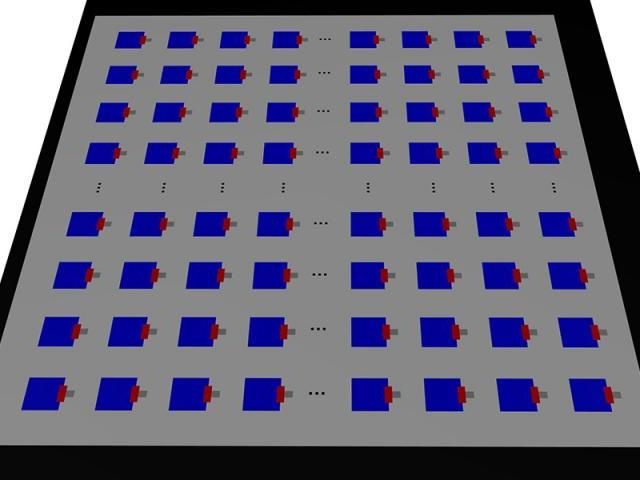Tiny graphene radios may lead to Internet of Nano-Things
Advertisement
For wireless communication, we're all stuck on the same traffic-clogged highway - it's a section of the electromagnetic spectrum known as radio waves.

The image, above, shows graphene-based nanoantennas (blue and red dots) on a chip.
University at Buffalo
Advancements have made the highway more efficient, but bandwidth issues persist as wireless devices proliferate and the demand for data grows. The solution may be a nearby, mostly untapped area of the electromagnetic spectrum known as the terahertz band.
"For wireless communication, the terahertz band is like an express lane. But there's a problem: there are no entrance ramps," says Josep Jornet, PhD, assistant professor in the Department of Electrical Engineering at the University at Buffalo School of Engineering and Applied Sciences.
Jornet is the principal investigator of a three-year, $624,497 grant from the U.S. Air Force Office of Scientific Research to help develop a wireless communication network in the terahertz band. Co-principal investigators are Jonathan Bird, PhD, professor of electrical engineering, and Erik Einarsson, PhD, assistant professor of electrical engineering, both at UB.
Their work centers on developing extremely small radios -- made of graphene and semiconducting materials -- that enable short-range, high-speed communication.
The technology could ultimately reduce the time it takes to complete complex tasks, such as migrating the files of one computer to another, from hours to seconds. Other potential applications include implantable body nanosensors that monitor sick or at-risk people, and nanosensors placed on aging bridges, in polluted waterways and other public locations to provide ultra-high-definition streaming.
These are examples of the so-called Internet of Nano-Things, a play on the more common Internet of Things, in which everyday objects are hooked up to the cloud via sensors, microprocessors and other technology.
"We'll be able to create highly accurate, detailed and timely maps of what's happening within a given system. The technology has applications in health care, agriculture, energy efficiency -- basically anything you want more data on," Jornet says.
The untapped potential of Terahertz waves
Sandwiched between radio waves (part of the electromagnetic spectrum that includes AM radio, radar and smartphones) and light waves (remote controls, fiber optic cables and more), the terahertz spectrum is seldom used by comparison.
Graphene-based radios could help overcome a problem with terahertz waves: they do not retain their power density over long distances. It's an idea that Jornet began studying in 2009 as a graduate student at Georgia Tech under Ian Akyildiz, PhD, Ken Byers Chair Professor in Telecommunications.
Graphene is a two-dimensional sheet of carbon that, in addition to being incredibly strong, thin and light, has tantalizing electronic properties. For example, electrons move 50 to 500 times faster in graphene compared to silicon.
In previous studies, researchers showed that tiny antennas graphene strips 10-100 nanometers wide and one micrometer long, combined with semiconducting materials such as indium gallium arsenide -- can transmit and receive terahertz waves at wireless speeds greater than one terabit per second.
But to make these radios viable outside the laboratory, the antennas need other electronic components, such as generators and detectors that work in the same environment. This is the work that Jornet and his colleagues are focusing on.
Jornet says thousands -- perhaps millions -- of these arrayed radios working together could allow terahertz waves to travel greater distances. The nanosenors could be embedded into physical objects, such as walls and street signs, as well as chips and other electronic components, to create an Internet of Nano-Things.
"The possibilities are limitless," says Jornet.
Jornet is a member of the Signals, Communications and Networks research group at UB's electrical engineering department, while Bird and Einarsson work in the department's Solid State Electronics research group.
The work described above is an example of the department's strategy to hire faculty members with complimentary expertise that drive the convergence of basic research areas while developing new technologies and educating students.
Other news from the department science
These products might interest you
Most read news
More news from our other portals
See the theme worlds for related content
Topic world Sensor technology
Sensor technology has revolutionized the chemical industry by providing accurate, timely and reliable data across a wide range of processes. From monitoring critical parameters in production lines to early detection of potential malfunctions or hazards, sensors are the silent sentinels that ensure quality, efficiency and safety.

Topic world Sensor technology
Sensor technology has revolutionized the chemical industry by providing accurate, timely and reliable data across a wide range of processes. From monitoring critical parameters in production lines to early detection of potential malfunctions or hazards, sensors are the silent sentinels that ensure quality, efficiency and safety.





































































